Surfing the North Shore of Maui: A Guide for Enthusiasts
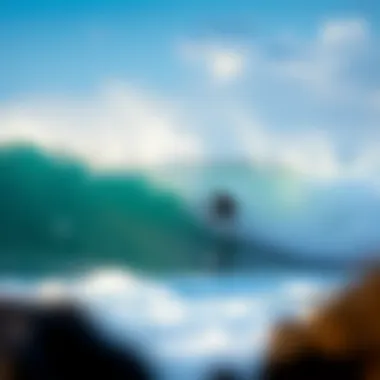
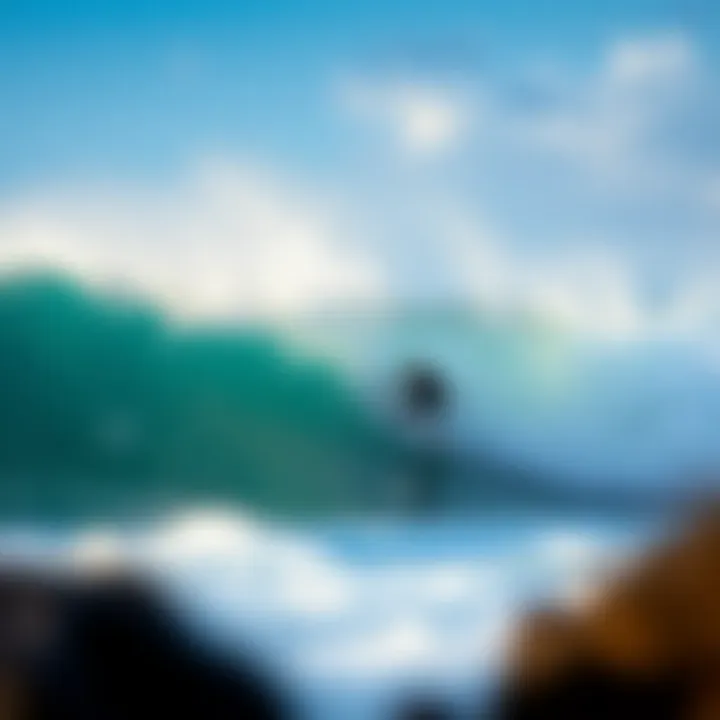
Intro
Surfing on the North Shore of Maui is more than just a sport; it's a vibrant culture wrapped in sun, sand, and rolling waves. This area is celebrated globally, attracting surf enthusiasts, professionals, and thrill-seekers alike. From the picturesque beaches to the roaring surf, every element combined offers a unique experience on the ocean.
In the coming sections, this guide dives deep into the artistry of surfing those pristine waves. Historical context provides a backdrop to the passion that loves on the North Shore, while a variety of surf spots invites both new and experienced surfers to carve their path.
Equipped with necessary knowledge about surf conditions, safety protocols, gear requirements, and tips tailored for all skill levels, readers will find practical wisdom intertwined with cultural insights. This piece melds the technical aspects of surfing with the environmental ethos that champions sustainability, thoroughly enriching the reader’s understanding of both the sport and the community surrounding it.
Let's dive into the heart and soul of this surfing haven.
Surfing Techniques
Advanced Maneuvers for Experienced Surfers
For seasoned surfers, the thrill often lies in executing advanced maneuvers that not only showcase their skill but also enhance their overall experience in the water. Techniques such as vertical snaps, aerials, and layback snaps require precision and creativity, often performed when conditions are most favorable.
- Vertical Snap: Perfect for generating speed and height, this maneuver involves turning sharply at the peak of the wave.
- Aerials: These involve catching a wave and leaping off the lip, landing back on the water with both style and control.
- Layback Snap: A show of control, this maneuver requires leaning back on the wave while executing a sharp turn.
Each of these moves demands time and practice; therefore, many surfers spend hours perfecting them.
Beginner Tips for Catching Your First Wave
For those paddling out for the first time, the ocean can seem intimidating and wild. However, with the right approach, it’s possible to catch your first wave without unnecessary stress.
- Choose the Right Board: A longer, wider board offers stability, making it easier to balance.
- Know Your Wave: Look for smaller, slower waves to begin with. They provide a gentler introduction to surfing.
- Practice Paddling: Before attempting to catch waves, get comfortable paddling out to the lineup. This builds endurance and confidence.
- Position Your Body: When you see a wave coming, point your board toward the shore, lie flat, and paddle hard to match the wave's speed.
- Stand Up: As you feel the wave pushing you, swing your legs beneath you and stand up in one smooth motion, bending your knees for stability.
Catching your first wave feels exhilarating, like a rite of passage into a timeless tradition.
Gear and Equipment Reviews
In-Depth Review of the Latest Surfboards
When it comes to choosing the right surfboard, it’s essential to match your selection with your skill level and surfing style. Popular brands such as Channel Islands and Firewire have evolved their designs to enhance both performance and buoyancy.
- Channel Islands Happy: Known for its versatility, this board accommodates all wave types, making it ideal for both new and experienced surfers.
- Firewire Seaside: This shortboard excels in smaller waves, holding speed and maneuverability, perfect for surf spots like Canggu Beach in Bali or the North Shore.
Exploring these options ensures surfers invest in a board that resonates with their surfing aspirations.
Essential Accessories Every Surfer Should Have
Beyond the board itself, having the right accessories can heighten the surfing experience. Consider the following:
- Leash: A reliable surf leash keeps the board attached during wipeouts, which is crucial for both safety and convenience.
- Wetsuit: Depending on the season, wearing a wetsuit can provide warmth and protection from the ocean's elements. Brands like O’Neill and Rip Curl offer great options.
- Wax: The right type of wax is essential for grip on the board. Always have a few bars handy, as conditions change.
Gearing up may seem like a chore, but selecting the right essentials creates not just safety but also enjoyment in the water.
With this deep dive into the techniques and gear needed for surfing on Maui’s North Shore, surfers of all levels can prepare themselves to ride those breathtaking waves.
Prologue to Maui's North Shore
Maui's North Shore is often hailed as a surfing mecca, and for good reason. The area boasts a unique blend of natural beauty, rich culture, and thrilling surf spots that attract water sports enthusiasts from around the globe. It’s not just about the waves here; it’s a place where the ocean tells stories and surfers seek both challenge and serenity.
Geographic Overview
Nestled on the northern side of the island, this region is marked by iconic cliffs, lush landscapes, and some of the most stunning beaches you can find. The North Shore stretches from Paia to Kapalua, with each beach offering different characteristics that cater to a range of skill levels. The proximity to the Pacific Ocean means that waves can vary dramatically throughout the year.
The geography plays a pivotal role in the surfing culture. The mix of volcanic rock formations and sandy shores creates diverse surfing conditions. For instance, beaches like Baldwin offer gentler waves, perfect for families and beginners, while the more powerful breaks at Jaws provide an exhilarating challenge for seasoned surfers.
Historical Context of Surfing in Maui
Surfing isn’t just a pastime on the North Shore; it's a centuries-old tradition that has evolved with the island's cultural landscape. The ancient Hawaiians were among the first to ride these waves, using wooden boards carved from local trees. This sport was interwoven with their customs and spiritual beliefs. Surfing was a way to communicate with the gods, and it was often practiced at sacred sites.
As the years rolled on, the sport transformed, influenced by various waves of settlers and visitors who brought their own styles and techniques. By the mid-20th century, the North Shore soared into the limelight, attracting surfers from far and wide, eager to ride its legendary waves. The area became synonymous with not just surfing, but also the lifestyle and philosophy surrounding it.
Today, the North Shore of Maui remains a canvas for surfers to connect with nature, embodying a profound respect for the ocean and its power. This complex history enriches the surfing experience here, making it not only a sport but also an homage to generations past.
"To surf is not just to ride the wave; it’s to embrace the stories it holds."
Understanding this history helps surfers appreciate the rich tapestry that is the North Shore, creating deeper connections to the sport and the land itself.
Surf Spots Along the North Shore
The North Shore of Maui is renowned for its surf spots that hold a unique allure for both aspiring surfers and seasoned wave riders. This coastline, with its contrasting tidal surges and tranquil coves, offers the perfect setting to understand the intricacies of the waves. Each surf spot is like its own character in a story, possessing distinct qualities that cater to various skill levels and preferences. Surfing here isn’t just about riding waves; it’s also about experiencing the local culture, the beauty of nature, and the adrenaline rush that comes from challenging oneself.
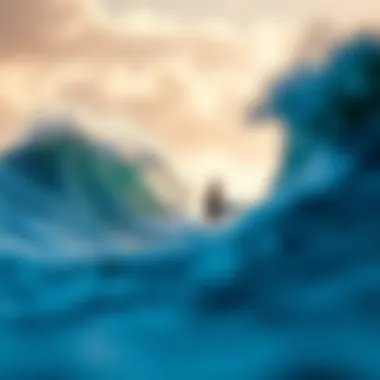
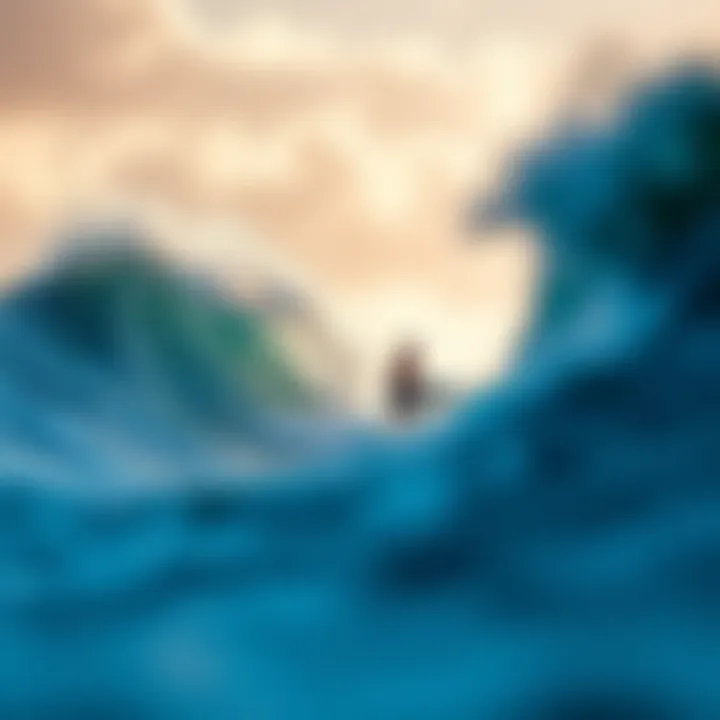
Peahi (Jaws)
Peahi, commonly known as Jaws, is legendary among the surfing community for its massive waves and intense environment. Surfers travel from all over the globe to showcase their skills at this infamous break. The sheer power and breath-taking nature of the waves here underscore why Peahi is both feared and revered.
Characteristics of the Break
Jaws is known for its huge swells, often reaching heights of over 30 feet during peak season. The break forms when north swells wrap around the top of the island, creating a steep wave face that rivals the best in the world. This characteristic makes it a thrilling spot for experienced surfers looking to push their limits. However, the rocky bottom adds an element of danger worth noting as it can easily lead to wipeouts.
Suitable Skill Levels
This surf spot is undoubtedly for the most advanced surfers. Beginners or intermediates should exercise caution; the waves are powerful and can be overwhelming. However, those who do dare try it often find that conquering these waves brings an unparalleled sense of achievement. Jaws demands both physical prowess and mental fortitude, categorizing the place as a proving ground for those destined to ride its gnarly waves.
Best Time to Surf
Late fall to early spring is when Jaws truly shines. The biggest swells roll in during these months, providing the best conditions. Surfing at this time amplifies the ride, turning the experience into something that feels almost ethereal. But bear in mind the risks; only the bold and well-prepared should attempt the massive waves during these months.
Hookipa Beach
Hookipa Beach is another gem on Maui’s North Shore, famous for its consistent waves and a community vibe that welcomes surfers of varying skill levels. Known for its windsurfing scene, it stands out as a versatile hub where surfers can explore their craft while basking in the scenic beauty of the ocean and landscape.
Wave Conditions
Hookipa offers a diversity of wave conditions that fluctuate with the tide. The waves can either close out in extreme conditions or produce long rides for those seeking finesse. Ideal for different types of boards, Hookipa accommodates changing styles, thus enriching every surfer's experience. This variety allows surfers to grow, adapt, and refine their technique in one spot.
Wind Directions
The wind at Hookipa tends to blow predominantly from the east, which creates ideal conditions for both surfing and windsurfing. Understanding the wind patterns is crucial as they can radically alter the quality of both sports. Sometimes, a minor shift in direction can mean the difference between an epically smooth ride and a bumpy struggle.
Surfing Etiquette
At Hookipa, respecting fellow surfers is vital. The community is tight-knit, and unwritten rules govern the lineup. For instance, allowing the person closest to the peak to take the wave is considered courteous. Such etiquette promotes harmony in the water, making the surfing experience enriching and enjoyable for everyone involved.
Baldwin Beach
Baldwin Beach caters to families and casual surfers, making it a standout option for those traveling with loved ones but still wanting to ride some waves. The wide beach is perfect for sunbathing while also featuring areas with mellow waves, ideal for novice surfers or families seeking a softer introduction to the sport.
Family-Friendly Surfing
With shallow waters that allow for safe play, Baldwin Beach is tailored for families. It generally has moderate surf conditions, making it an excellent choice for children and inexperienced surfers. This aspect transforms it into a welcoming environment where families can bond and enjoy quality time together while engaging in water activities.
Seasonal Variations
Surf conditions at Baldwin Beach vary greatly with the seasons. During summer, the waves are generally smaller, making it a perfect time for beginners to hone their skills. In contrast, winter brings in bigger swells, attracting an assortment of surfers eagerly looking for a challenge. These seasonal changes cater to all preferences, from casual fun to more demanding experiences.
Safety Considerations
While Baldwin Beach is family-friendly, ocean safety should be a priority for all. Parents should watch their children closely, especially when the surf picks up. Awareness of the currents and potential riptides is essential in keeping a safe environment. By preparing adequately and understanding local conditions, the beach can remain a safe place for all.
Riding the waves on Maui’s North Shore isn’t just a sport, it’s a rite of passage that connects surfers with the ocean and the island itself.
Understanding Surf Conditions
Surfing is not just about riding the waves; it’s about knowing what those waves are doing and why. Understanding surf conditions is critical for surfers, from novices to seasoned pros, as it helps them maximize their experience in the water. Here, we’ll break down some essential components that directly influence surf conditions and explain the ways in which they can shape your outing.
Tides and Their Influence
Tides play a fundamental role in the dynamics of surf conditions. The gravitational pull of the moon and sun causes the water levels to rise and fall, which in turn can impact wave quality.
When it's low tide, waves may break differently compared to high tide. Certain spots, like Hookipa Beach, have their best waves at specific tide levels. If you're looking to catch a memorable session, be sure to check local tide charts like those found on Tide Charts or Surfline beforehand.
Understanding how tides function can also help surfers avoid dangerous conditions. As the tide rises or falls, rocks and shallow areas can become exposed, making it vital for surfers to keep an eye on them. Surfers must calculate when to paddle out and when to head for the shore, depending on the tide. Therefore, understanding tidal patterns is a skill that will benefit any surfer.
Surf Swell Patterns
Next up are swell patterns, which are essentially the undulating movements of the water caused by winds and storms far out at sea. A swell can travel hundreds of miles before reaching the shores of Maui, where it transforms into the beloved waves surfers chase.
Waves are generated by wind blowing across the surface of the ocean. The direction, speed, and consistency of the wind affect the quality of the swell. There are three types of swells: ground swells, wind swells, and refracted swells. A ground swell is usually preferred for surfers as it tends to create well-formed waves that hold up longer.
To better gauge swell patterns, a resource like Surfline provides forecasts that indicate wave heights and intervals between sets. The longer the interval—the more time between waves—the more powerful and cleaner the wave will usually be. Paying attention to these details can give you a significant advantage when seeking the perfect ride.
Weather Patterns
Weather conditions directly influence the experience of surfing. Factors such as wind speed, temperature, and cloud cover can change the atmosphere in which surfers operate. For instance, overcast skies may deter some, while others find that the best surf happens right before a storm. It’s a mixed bag, really.
Strong winds can create choppy conditions that aren’t ideal for most surfers. They can muddle the waves, making them unpredictable and less enjoyable to ride. On the other hand, a light offshore breeze frequently enhances wave quality. Many surfers will tell you that calm days with little to no wind make for the best conditions.
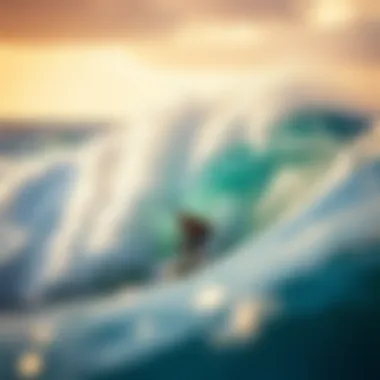
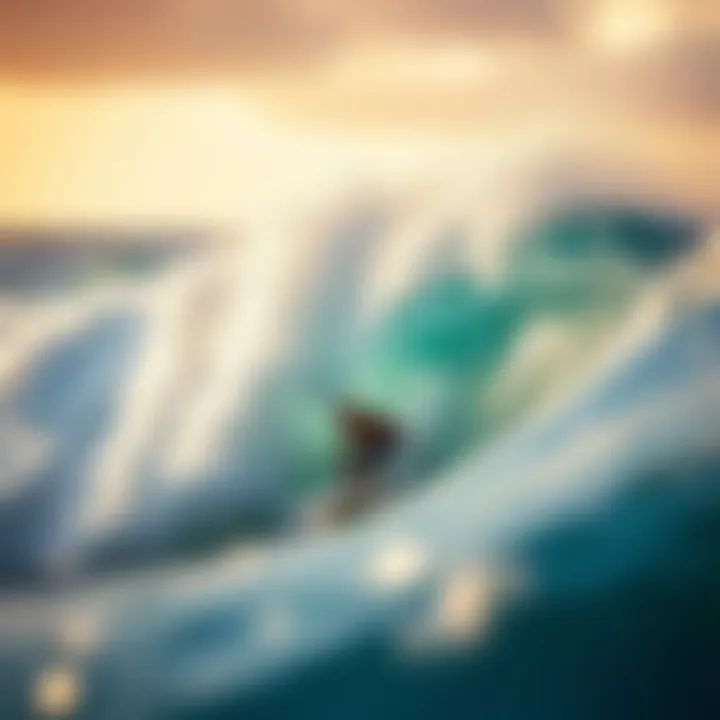
For keen surfers, getting used to checking weather forecasts should become second nature. Websites like Weather.com provide detailed environmental forecasts that can help surfers find the best times to get in the water. Keeping an eye on local weather alerts ensures that you’re not only prepared to surf but that you remain safe while doing so.
Ultimately, a careful understanding of surf conditions, including tides, swells, and weather, can make or break your surfing experience on the stunning North Shore of Maui.
In summary, delving into the nuances of surf conditions can greatly enhance your enjoyment in the water. With the right knowledge at your fingertips, you’ll be more equipped to tackle the waves and make the most of what Maui has to offer.
Safety Guidelines for Surfers
Understanding safety guidelines for surfers is critical, especially on the North Shore of Maui, where the waves can be both beautiful and formidable. Knowing these guidelines can not only enhance your surfing experience but also ensure your well-being and that of others around you. This section aims to dive into two essential aspects: ocean awareness and shark behavior. By familiarizing yourself with these elements, you can navigate the waters with greater confidence and consideration.
Ocean Awareness
The ocean is a living entity, teeming with power and unpredictability. It’s not just about riding the waves; it's knowing what's happening in the water. Being ocean aware means understanding currents, tides, and swell patterns. Each beach has its unique characteristics and knowing them is key to safe surfing.
For instance, at places like Peahi, also known as Jaws, powerful swells can create unpredictable currents that might sweep even the most experienced surfer off their feet. It's important to:
- Observe the Conditions: Spend time on the shore before hitting the water. Watch how waves break and any potential hazards.
- Know Your Limits: Understand when to take a break, especially if conditions are beyond your comfort zone.
- Practice Situational Awareness: Be aware of other surfers, potential obstacles, and the environment. An active mind can prevent accidents.
Being in harmony with the ocean greatly enhances your surf experience and reduces risks. Remember, safety is not just personal; it encompasses every surfer in the water.
Shark Behavior
Shark encounters are one of the most talked-about fears among surfers. While it's easy to let paranoia get the best of you, it's vital to ground yourself in the facts about shark behavior and interactions. Truth is, most sharks are not a threat to surfers.
That said, there are certain behaviors to keep in mind:
- Time of Day: Sharks are more active during early morning and late afternoon. If you’re planning a session, consider hitting the waves during midday for a reduced chance of encounters.
- Avoid Murky Water: Sharks often hunt in murky conditions. If visibility is poor, it's best to steer clear of those spots.
- Don't Surf Near Schools of Fish: If you see plenty of fish activity, it can attract sharks. It’s a clear sign to stay away.
Sharks play a vital role in the marine ecosystem, and having respect for them is crucial. By understanding their behavior, you can minimize risks and share the ocean respectfully.
"Surfing is not just a sport; it’s a connection with nature. Understanding its rhythms can make all the difference in your safety and enjoyment."
Equipment Essentials
When it comes to surfing the North Shore of Maui, the right equipment can make all the difference between a great day on the water and a struggle against the elements. Tackling its powerful waves requires not just skill but also the right gear tailored to the unique conditions of this surf haven. Here, we’ll discuss essential equipment, focusing particularly on surfboards and wetsuits or rash guards, both crucial elements for anyone looking to hit the waves substantialy.
Choosing the Right Surfboard
Selecting the proper surfboard isn't merely about aesthetics or brand names; it’s about understanding how each board functions and what will serve you best on the water. Surfboards come in a variety of shapes and sizes to adapt to different conditions and surfing styles.
Board Types
One of the most critical aspects to consider is the board type. You’ll often hear terms like shortboard, longboard, fish, and funboard. Each of these has unique characteristics that cater to different surfing experiences. For instance, shortboards are known for their agility and speed, making them a popular choice for experienced surfers who thrive in challenging conditions. On the flip side, longboards offer superior stability, allowing newcomers to get comfortable without feeling overwhelmed by the ocean's might.
Every board carries its own flair: a fish board, for example, has a broader outline and is designed for smaller waves, letting surfers catch and ride them with greater ease. However, this uniqueness also implies varied levels of performance in distinct surf situations, so understanding the differences can significantly enhance one’s surfing experience.
Volume Considerations
The volume of a surfboard, which refers to its buoyancy, plays a huge role in your overall surfing experience. Volume is typically expressed in liters; more volume means more flotation, which is particularly favorable for beginners who need support while learning to balance.
Higher volume boards make paddling out easier and help you catch waves more effortlessly. On the contrary, those in need of performance—like advanced surfers—might opt for a lower-volume board to encourage a snappier responsiveness.
As you think about your time on the North Shore, knowing your comfort with volume also contributes to how you’ll interact with the wave conditions. Higher volume can protect you against wipeouts, while lower volume provides the precision deathmatch against steeper, powerful waves.
Wetsuits and Rash Guards
With the fierce elements of nature being what they are, staying comfortable while surfing is paramount. Wetsuits and rash guards not only elevate your surfing experience but also provide vital protection against the sun and ocean hazards.
Materials and Thickness
When selecting a wetsuit, materials and thickness matter considerably. Most wetsuits are made from neoprene, which keeps the body warm by trapping a thin layer of water next to your skin. Thicker suits (usually 4/3mm or 5/4mm) keep you warm in cooler months, while thinner suits (like 2mm) are better suited for warmer conditions typical of Maui’s North Shore.
These wetsuits excel in offering insulation against the chill Pacific waves while providing flexibility for those radical moves. However, thicker suits might restrict movement slightly, which can be a disadvantage if you're planning to do some serious wave riding.
Fit and Functionality
Finally, the fit and functionality of your wetsuit should not be overlooked. A well-fitting wetsuit will feel like a second skin and allow for ample mobility. You want to minimize water flow while maximizing comfort. A suit that’s too loose will let water flood in, which can quickly sap your body heat, while a suit that's overly tight can restrict movement.
Most wetsuits come in a variety of cuts like back-zip, chest-zip, and shorty depending on your preferences and the weather in Maui. Pay attention to the construction techniques, such as sealed seams, as they can enhance durability while reducing water penetration.
As a rule of thumb, invest in high-quality suits to withstand the rigorous conditions and to ensure buoyancy during your waves sessions. Don't forget about rash guards—these lightweight fabrics provide a thin layer of protection against rash from the board and against harmful UV rays.
In summary, choosing your gear wisely and understanding these elements will greatly enhance your surfing prowess on the North Shore of Maui, helping you glide through the surf while you enjoy everything this beautiful locale has to offer.
Cultural Significance of Surfing
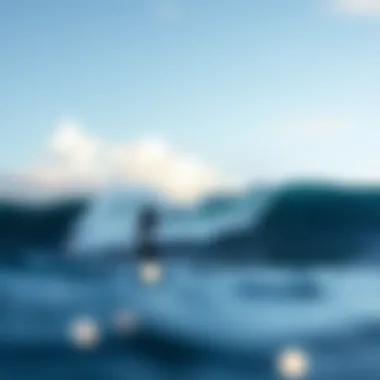
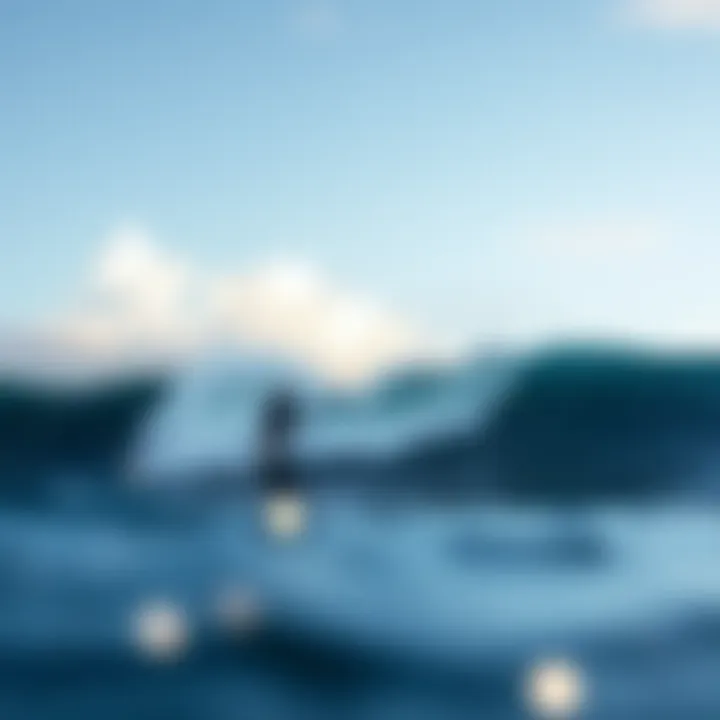
Surfing on the North Shore of Maui transcends the mere act of riding waves; it embodies a rich tapestry of culture and community. The significance of this sport is woven into the social fabric of the islands and reflects deep historical roots. Surfing here isn't just an adrenaline rush but a connection to the ocean and heritage, binding generations. Local surfers hold the ocean with reverence, and this relationship is a testament to their identity, reflecting values that extend beyond just sport.
Local Traditions
Surfing has been a traditional practice in Hawaiian culture for centuries, often referred to as “He’e Nalu”, meaning “to glide on a wave.” It serves as a medium of storytelling, where legends are told through the rhythms of the surf. Many local families pass down their surfing skills as a rite of passage, emphasizing the importance of mentorship and community bonding.
In addition, local surf competitions often showcase not only skill but also the spirit of Aloha, celebrating respect and love for each other and the ocean. These events are akin to community festivals, where food, music, and storytelling come together. For instance, at Hookipa Beach, the annual contests attract both locals and visitors, creating a dynamic exchange of traditions.
The art of surfboard making, too, holds cultural significance. Craftsmen pour their energy into carving boards, often using traditional methods and materials. An exquisite board isn't merely a tool; it’s an emblem of artistry that narrates the individual's relationship with the ocean. These connections help keep the local culture alive and thriving, making every wave ridden a nod to the past and a step into the future.
Environmental Stewardship
As much as surfing is celebrated, it carries immense responsibility. The North Shore, with its pristine beaches and rich biodiversity, is a cherished resource, not just for surfers but for all who honor the ocean. Environmental stewardship within the surfing community is of utmost importance. Surfers are often the first to notice changes in ocean health, such as water pollution, coral degradation, and habitat loss.
The rise of eco-conscious surfing is evident. Many surfers advocate for clean ocean initiatives, organizing beach clean-ups and participating in conservation programs. By utilizing biodegradable surfboards, eco-friendly wax, and other sustainable equipment, surfers are making strides toward a greener footprint. This proactive approach encourages a dialog about environmental issues, inspiring others to respect and protect marine ecosystems.
Sustainability Practices in Surfing
In the realm of surfing, there lies a growing recognition of the necessity for sustainable practices, particularly in awe-inspiring locales like the North Shore of Maui. Surfing inherently engages with natural environments; thus, it’s crucial to tread lightly on the waters that provide so many thrills. Embracing sustainability goes beyond simple maintenance of the beaches; it charts a pathway toward preserving these iconic surf spots for future generations.
Eco-Friendly Gear
When surfing, the first thing that comes to mind is usually the board. But have you ever considered the impact your gear has on the planet? There are countless options out there that blend performance and eco-consciousness. For instance, surfboards made from sustainable materials like EPS foam and bio-resins are now available. These materials offer an environmentally friendly alternative to traditional fiberglass. Some brands are even taking a step further, creating boards from recycled materials – a perfect way to catch waves while helping the Earth.
Another area to look at is wetsuits. Conventional neoprene can be tough on the environment, but newer wetsuits made from Yulex, a plant-based rubber derived from sources such as rubber trees, offer a more sustainable substitute. It works similarly, but with much less ecological harm.
Here are a few other options worth considering for eco-friendly gear:
- Recycled towels and accessories: Look for products made from post-consumer waste.
- Solar-powered chargers for your devices: Keep your tech running while harnessing renewable energy.
- Biodegradable surf wax: Avoid the plastic waste with natural alternatives like beeswax or coconut oil-based waxes.
"Every small choice counts. By opting for eco-friendly gear, surfers are actively contributing to the wellbeing of the oceans and communities they love."
Conservation Tips for Surfers
Engaging in conservation is another essential facet of sustainable surfing. Surfers can become stewards of their environment by being aware and taking steps to protect the ocean and beach ecosystems. Here are several ways to pitch in on that front:
- Leave No Trace: Always pack out what you pack in. This includes trash, half-eaten sandwiches, and plastic bottles. The ocean is not a garbage dump.
- Be Mindful of Marine Life: Respect the local fauna by keeping your distance from wildlife. Getting too close can disturb their natural behavior, leading to potential harm.
- Participate in Beach Clean-ups: Join community efforts to clean beaches regularly. It's a great way to engage with like-minded individuals while safeguarding crucial habitats.
- Support Local Conservation Organizations: Many groups focus on keeping the waters clean and promoting marine health. Join or donate to organizations like Surfrider Foundation, which focuses on protecting ocean waves and beaches.
Combining sustainable practices in surfing with active conservation efforts helps preserve the thrilling experience of riding the waves. A healthy ocean equates to better waves, and it’s up to each surfer to ensure those waves remain for the future.
Travel Tips for Surfers
When preparing for a surfing adventure on the North Shore of Maui, having some valuable travel tips can make all the difference between a good trip and a great one. Understanding the local environment, customs, and logistics can enhance your experience significantly. Here, we break down what you need to know for a smooth surfing getaway.
Best Times to Visit
The timing of your visit can greatly influence the quality of your surf sessions. Generally, the winter months from November to March offer the biggest swells. This is when experienced surfers flock to spots like Peahi and Hookipa, drawn by the promising wave conditions. However, if you're just starting or are at an intermediate level, consider visiting during the summer months, from June to September, when the waves tend to be smaller and more manageable.
- Winter Surf Season:
- Summer Surf Season:
- Ideal for experienced surfers
- Bigger, more challenging waves
- Crowded at popular spots
- Perfect for beginners
- Smaller, gentler waves
- More space at surf spots
Additionally, the weather is pleasantly warm year-round, but be prepared for sudden shifts, especially in the winter. A handy trick is to check the surf reports before you arrive, ensuring you catch the best conditions, and with apps or websites like Surfline or Magicseaweed, finding the right waves is just a click away.
Accommodations and Accessibility
Finding the right place to stay can enhance your surfing experience significantly. The North Shore offers a variety of accommodations catering to different budgets and preferences. Options range from resorts like the Turtle Bay Resort with premier amenities to more rustic, budget-friendly Airbnb choices. Here’s what you should keep in mind:
- Location Matters: When selecting your accommodation, aim for proximity to your favorite surf spots. This could save you valuable time and energy. Staying closer to areas like Waimea Bay or Sunset Beach makes it easier to hit the waves early.
- Accessibility and Transportation: The North Shore has limited public transportation, so renting a car is often the best option for surfers looking to explore various beaches. Most surf spots are quite accessible by road, but some may require a bit of a hike. Make sure to keep your vehicle stocked with beach essentials like towels, sunscreen, and water.
- Local Recommendations: Don’t shy away from asking locals for insights on the best places to stay or eat. They often have hidden gems that can enhance your journey, from cozy diners dishing out the freshest poke to charming cottages just steps away from the beach.
Overall, the right mix of timing, accommodation, and local insight can turn a standard surf trip into an unforgettable experience, deeply connecting you to the waves of Maui's North Shore.
Closure
Reflecting on the North Shore experience is not just about the thrill of catching waves or the adrenaline that surges through a surfer’s veins. It goes deeper, touching the essence of what it means to be part of this vibrant, interconnected surf community. This region, pivotal to the history of surfing, offers a unique interplay of natural beauty and cultural significance. The rich tapestry of experiences that one finds here ranges from the raw, powerful waves of Peahi to the more family-oriented waters of Baldwin Beach.
When surfers navigate the waters of the North Shore, they’re not just riding swells; they’re participating in a longstanding tradition. Each surf spot has not only its unique characteristics but also its own local challenges and etiquette. Understanding these nuances can enrich one’s time spent in the water. From the proper respect for local customs to maintaining ocean safety, the North Shore experience teaches surfers about harmony with nature and community.
As the world evolves, so does the practice of surfing. It’s crucial to recognize the environmental considerations that come with riding these majestic waves. Surfers must balance the joy of the sport with the responsibility of protecting the coastline and its ecosystems. This commitment to sustainability ensures that future generations can experience the same thrill.
The Future of Surfing on Maui
Looking to the future, it is essential to ponder how surfing on Maui might change. The increasing popularity of the sport means more surfers flocking to the North Shore. This influx presents challenges, such as overcrowding in the water and increased environmental impact. The potential for conflict over wave priority among surfers intensifies with more individuals vying for the same break. Thus, the need for effective management and community involvement becomes paramount.
On a more positive note, innovation in surf equipment and gear continues to advance rapidly. New materials that are lighter, more durable, and environmentally friendly are now more readily available. This encourages beginners to join in while enabling seasoned surfers to push their limits in performance and safety.
In terms of local culture, the North Shore continues to foster a strong sense of identity through surf events and competitions. These gatherings not only attract global attention but also unify local surfers and promote a healthy competition spirit. Events highlight not only skill but community and passion for the ocean.
Ultimately, the future of surfing on Maui hinges on the balance between preservation and exploration. By respecting the local culture and promoting sustainable practices, today’s surfers can help create a legacy that others will follow. Surfers have a unique position at the forefront of environmental consciousness, highlighting the importance of preserving our oceans for the enjoyment of future generations.















